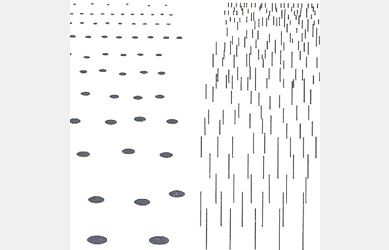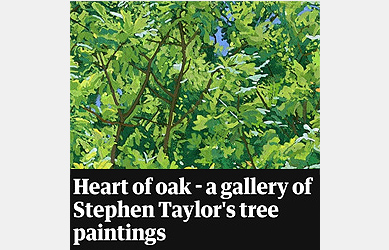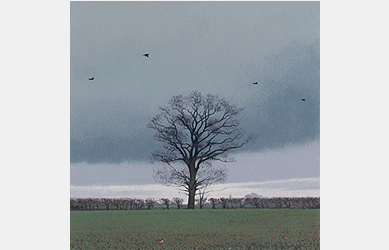Da Hier ist ein Baum
Presence is a Tree
a philosophical appreciation
Rosario Gianino, Etempodescrivere, July 2009
Says Stephen Taylor, painter, "For the greater part of my adult life I have observed aspects of the material world. In particular, in the last few years I have been interested in how the play of light and colour in nature changes when one looks towards and away from the sun ."
Studying paint (la materia - the material) to succeed in fixing a unique, unrepeatable shade of light, reflecting from various 'material essences', making of the gaze an object, making it a world... This is incredibly poetic and is really the creative essence of poetic description. In his dedication to this aesthetic of poetic description Stephen Taylor is a timeless brother of Titian. Taylor's works, made by this way of looking, deserve to be seen; look, and you will be led to the wisdom which invites contemplation of our mysterious and irrreducible "Other".
Thus boundaries of the greatest interest, boundaries between the self and the other, become to us natural - whether a curled up leaf or the shadow of a magnetic, centuries old tree. The art of description makes us pay attention to that which is different to us and to recognize that which surpasses us and which materially contains us. It is in this recognition that spiritual comprehension appears, as Hegel and Spinoza taught, and as Calvino's Signor Palomar aspired to.
I came to know this painter thanks to Alain de Botton who wrote about him in his Pleasures and Sorrows of Work. The objects of faithful, meticulous attention, imitated and at the same time created by the artist Stephen Taylor, are moss, lichen, leaves, water, sky, fields... Above all an oak tree, to which he has dedicated years of work in the open air in all seasons and at all hours of the day and night, over fifty times. How?
With material pigments, with oil painting. The obsessive challenge to improve his technique of mixing colours, the craftsman's manual research into the material itself has as a result: A transparent style, pierced with light.
Thus, in the manipulation of paint and brush, is the enchanting magic of the sensitive reproduction of an idea. To speak philosophically, the teleology1 of inner sight which exists in the artist, is - as in his work - the reason it exists, of and within the phenomenal aura of his world. In the web of manifestations of this aura appears, new each time, a stability of relation between diverse elements, an emerging concourse of perceptual physiology, the physical coloured alchemy of paints, the illumination and reflections from objects, the agile precision of a hand, the complex control of a brain, the story and emotions of a possible spectator - the richness of the here and now.
This aesthetic vision is a miracle of beauty and judgment, of intuitive understanding. Many great painters have painted oak trees. Mario Rigoni Stern in Arboreto Selvatico records the sacred oaks of Gaul which, Tacitus says, the Roman soldiers could not penetrate or overcome. Around and under the oak the first churches and the first assemblies and communities in Northern countries were formed.
In the second book of Tolstoy's War and Peace, Adrei, in his springtime, searched among birches and firs for an oak tree, angry, stubborn, unmovable. At first the oak inspired in him the sweet melancholy of the end of youthful illusion. But, after having listened to the moonlit confession of Natasha, when he saw it again the tree - the same tree - was transfigured, renewed. The same but different. The two sights of the same oak produced in him a profound and memorable impression, corresponding to an intuition about the sense of life itself:
'If this oak tree is right, it is a thousand times right.'
If in Tolstoy the oak is a symbol of life which renews its promises, in a story that is preeminently about the here and now, in Stephen Taylor the oak is an apparition of this truth, in the epistemological2 nature of the gaze. A sum total of being one's self - sub specie eternatis3.
This reality of the present is ours; but even more amazingly, at the same time it does not depend on us.
And we can even ask, from a certain point of view, in the world beyond the canvas, Are there still trees?
words
- teleology : the explanation of phenomena by the purpose they serve rather than by postulated causes.
ORIGIN mid 18th cent. (denoting the branch of philosophy that deals with ends or final causes): from modern Latinteleologia, from Greektelos 'end'+-logia(see-logy
- epistemology : the theory of knowledge, esp. with regard to its methods, validity, and scope. Epistemology is the investigation of what distinguishes justified belief from opinion.
ORIGIN mid 19th cent.: from Greekepistēmē'knowledge,'fromepistasthai 'know, know how to do.'
- Latin. Roughly, "from the perspective of the eternal".
Translation from Italian Wylva Andon
editing Stephen Taylor




